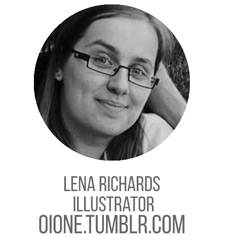Illustrator Lena Richards has an eye for the surreal and otherworldly. In this flashback to issue 109 she gives us a peak at her unique sketches, explorations and inspirations.
I’ve never had a definitive sketchbook until lately. The nature of my job requires using different styles, so I just used to try random techniques and mix colors in it. And slowly, without noticing it I started to draw my own imaginary world that has pretty consistent features‒ surreal, maybe weird, with some unexpected parts, a world where usual objects may have an unusual use and it’s a norm for that world. Suddenly instead of just practicing I started to have infinite fun with drawing.
A big part of it is still the exploration of existing things, like sketching animals at the zoo, because all that comes from our imagination is more or less just a mosaic from what we have seen or experienced, so the more the better. I spend a lot of time sketching in the library, museum or weird shops with tiny interesting objects.
I don’t really like staying home unless I paint digitally, so my work space becomes coffee shops when I want to draw people or an old library in the University district of Seattle when I crave for silence and mystically floating around. All this is transformed into my sketchbook.

A pretty typical sketch for me: what if fish could fly?

It’s a fun exercise to add an unusual gigantic object in the scene surrounded by the same objects of regular size. It reinforces the weird factor
Inspiration and Ideas
Inspiration is always around us. As Jean-Luc Godard once said, “It’s not where you take things from — it’s where you take them to.” So I do precisely this. If I see an interesting person that, for example, looks like a bird – I make him one! I transform landscapes I see into magical places with odd shapes and growing spiral trees, I make fish float instead of clouds… because it’s fun to do!

I like taking characters from my previous sketches and place them in new sketches of locations
Materials
I don’t really care much about the materials I use. I equally love traditional and digital sketching. It used to be that I had actual sketchbooks, but I walk a lot and always take my drawing with me, and my sketchbooks got ruined. So I started to carry around a clipboard with several sheets of regular office paper, which I can just leave at home later or give away to people if they like something I draw.
I have my crazy pencil case though, where there’s dozens of different pens, inks and pencils. My only tool preference is the ability to make fine lines ‒ I love working on patterns and surfaces.
As for digital sketching ‒ I use it mostly to work straight in color.

An abstract landscape

Animals are a big part of my sketches, but I always like to add something that will make them look odd and magical
Sketching Techniques
Drawing is a dirty fight with yourself ‒ any trick will do. I’m just trying to keep myself interested. It’s pretty rare for me to use a sketch for an actual painting, and even if I do I mostly use it as a reference and re-paint the sketch completely to get a fresher feeling of what I’m doing.
I’m a pretty messy drawer, so I like to use tools of different colors. I make sketches with blue or red mechanical pencils, then ink them or make a new layer of lines with regular graphite pencil. The layer of colored lines is usually pretty loose so I can still explore lines and have fun.
You see, for me sketching is all about staying entertained, because at a certain point I got really used to digital drawing which is fast and easy to fix if needed, where as the results of traditional drawing may turn more time consuming to obtain the result we want. So I look for small tricks that will let me solve part of the “problems” later on and release me from pure execution.

Adding patterns are really important because it creates the feeling of legitimacy of any made-up fantasy race or culture

As a concept artist characters are a big part of my sketches. I use markers or just lasso selections later in Photoshop to divide patterned parts into simpler chunks for understanding
Click here to see more from 2dartist issue 109

